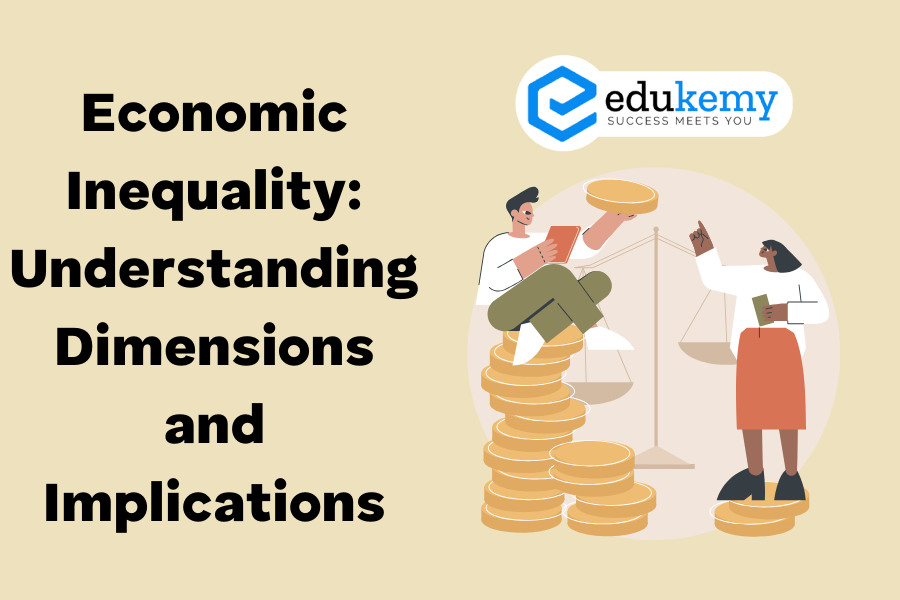
Economic inequality encompasses the uneven distribution of income, wealth, consumption, and opportunities within a society. It manifests in various dimensions, providing a comprehensive view of disparities among different groups.
Contents
Key Dimensions:
- Income Inequality:
- Focuses on the uneven distribution of income among the population.
- Income inequality is not only about the current flow of income but is also intertwined with the accumulation of wealth, generating periodic returns.
- Wealth Inequality:
- Involves the uneven distribution of financial assets, physical property, gold, and other forms of wealth.
- Wealth inequality considers the stock of assets that individuals or groups possess, reflecting their economic standing.
- Consumption Inequality:
- Arises from increased income and wealth inequality, influencing the quality and quantity of goods and services consumed.
- Wealthier individuals tend to consume more in terms of food, shelter, electricity, transportation, and other material and intangible goods.
- Inequality of Opportunity:
- Reflects disparities in access to essential services and opportunities.
- Well-off individuals often have privileged access to quality healthcare, education, entertainment, and communication, while others may face limitations.
Complex Dynamics:
- Economic inequality does not necessarily equate to poverty. It’s plausible for both the rich and poor to experience improvements in their economic status, but excessive inequality can have adverse effects.
Determinants of Economic Inequality:
- Economic System: The structure and functioning of the economic system contribute to inequality.
- Access to Assets: Unequal access to resources and assets amplifies disparities.
- Legal Framework: Laws and regulations can either mitigate or exacerbate economic inequality.
- Education and Skills: Disparities in education and skills influence earning potential.
- Social Factors: Caste, gender, and other societal factors contribute to differential economic outcomes.
Implications:
- High levels of economic inequality can lead to social unrest and hinder overall economic development.
- Excessive concentration of wealth and opportunities may limit social mobility.
- Addressing economic inequality often requires a multi-faceted approach, involving economic, social, and policy interventions.
Conclusion: Understanding economic inequality involves recognizing its multifaceted nature and exploring its dimensions beyond income alone. Efforts to address inequality must consider a range of factors and focus on creating inclusive opportunities for all members of society.
FAQs
1. What is economic inequality?
- Economic inequality refers to the unequal distribution of wealth, income, and resources among individuals or groups within a society. It encompasses disparities in earnings, assets, opportunities, and access to basic necessities such as education and healthcare.
2. What are the primary dimensions of economic inequality?
- Income Inequality: Disparities in earnings or income levels among individuals or households.
- Wealth Inequality: Differences in accumulated assets, including property, investments, and savings.
- Opportunity Inequality: Variances in access to education, employment, healthcare, and other resources that affect one’s socioeconomic mobility.
- Intergenerational Inequality: The perpetuation of economic disparities across generations, often due to unequal opportunities and inheritance.
- Global Inequality: Disparities in income and wealth distribution between countries or regions, influenced by factors such as trade policies, colonial legacies, and globalization.
3. What are the implications of economic inequality?
- Social Cohesion: High levels of economic inequality can lead to social unrest, mistrust, and polarization within societies.
- Economic Growth: Excessive inequality may hinder economic growth by limiting opportunities for human capital development and consumption.
- Health and Well-being: Economic disparities can exacerbate health inequalities, leading to disparities in life expectancy, access to healthcare, and overall well-being.
- Political Influence: Concentrated wealth often translates into disproportionate political power, potentially undermining democratic principles and policymaking processes.
- Interpersonal Relations: Economic inequality can strain interpersonal relationships, fostering resentment, envy, and societal divisions.
4. What factors contribute to economic inequality?
- Structural Factors: Systemic issues such as unequal access to education, discriminatory policies, and market distortions contribute to persistent economic disparities.
- Technological Change: Automation and globalization have led to shifts in labor markets, often benefiting skilled workers while displacing others, exacerbating income inequality.
- Policy Choices: Tax policies, social welfare programs, and labor market regulations can either mitigate or exacerbate economic inequality, depending on their design and implementation.
- Cultural and Social Norms: Prevailing attitudes toward wealth accumulation, meritocracy, and social mobility can influence patterns of economic inequality.
- Historical Context: Legacies of colonialism, slavery, and other forms of exploitation can shape current patterns of economic inequality within and between societies.
5. How can society address economic inequality?
- Progressive Taxation: Implementing progressive tax policies that levy higher taxes on the wealthy can help redistribute wealth and reduce income inequality.
- Investment in Education and Healthcare: Prioritizing investments in education, healthcare, and social safety nets can improve equality of opportunity and promote social mobility.
- Labor Market Reforms: Enacting policies to ensure fair wages, protect workers’ rights, and promote job creation can help reduce income disparities and improve overall economic equality.
- Social Policies: Implementing targeted social welfare programs, such as unemployment benefits, affordable housing initiatives, and universal healthcare, can mitigate the adverse effects of economic inequality.
- Addressing Structural Barriers: Tackling systemic issues such as discrimination, unequal access to resources, and market distortions is essential for addressing long-term economic inequality.
In case you still have your doubts, contact us on 9811333901.
For UPSC Prelims Resources, Click here
For Daily Updates and Study Material:
Join our Telegram Channel – Edukemy for IAS
- 1. Learn through Videos – here
- 2. Be Exam Ready by Practicing Daily MCQs – here
- 3. Daily Newsletter – Get all your Current Affairs Covered – here
- 4. Mains Answer Writing Practice – here

